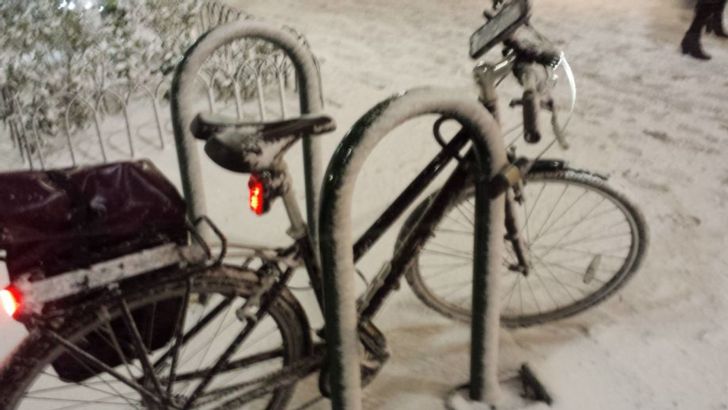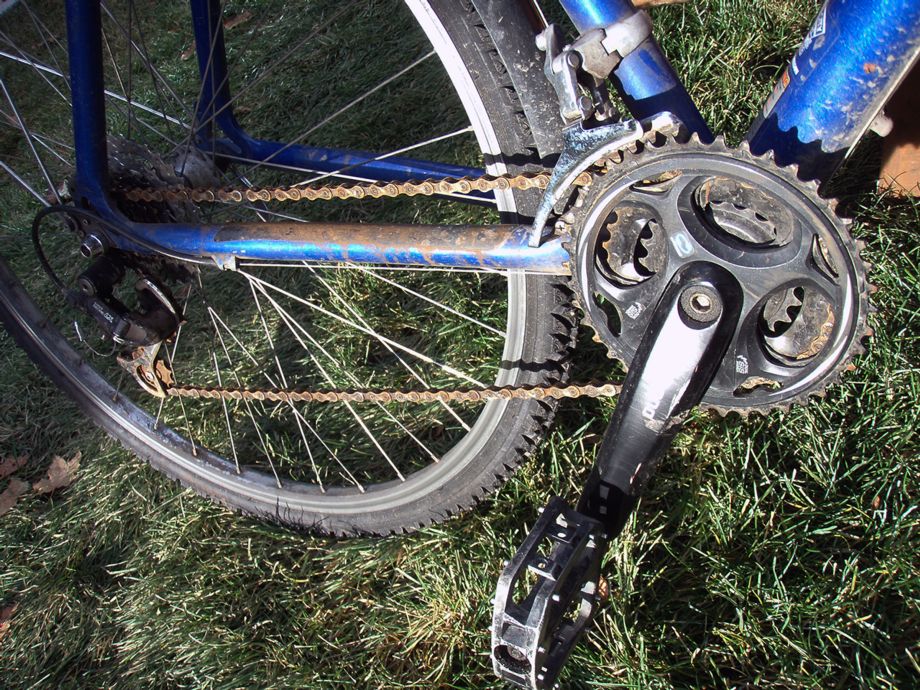A Winter Biking Guide!
Oh no! You glance outside your office window and realize your bike is covered in snow. What now? It's a typical scene for us in Missoula, Montana. Here are some recommendations for bike commuting in the snow and ice from our Tours Specialist Emma Wimmer.

My bike, left outside for 5 minutes in a snow squall.
Emma Wimmer
While you're reading through these tips for riding in the winter, think of hints you'd like to include and add them to the comments below. This is what will make your human-powered winter travel easier.
Clothing
Bike clothing
- Lobster claw gloves.
- Cycling/running tights.
- Arm & leg warmers. My favorites!
- Cycling Gaiters.
- Booties/shoe covers.
Non-Cycling specific clothing
- Long underwear. Avoid cotton like you avoid riding over nails. It will absorb water from the rain, snow, or your sweat, and conduct heat away from your body. Go for wools, silk, or synthetics.
- Wool socks. Is there a finer fabric than wool? Tough. Not so stinky, since it's naturally antimicrobial and it can keep you warm even if it gets wet.
- Ski goggles. You know the weather is nasty when you're glad you had your ski goggles!
- Neck gaiter or balaclava.
- A hat that will fit under your helmet. Here's an example.
Other Gear & Accessories
- Front and rear lights.
- Fenders are good for preventing the "skunk stripe" on your back from mud and slush.
- Reflective vest/safety triangle.
- Bar mitts.
Bikes
As for a bike, there are many options!
- Mountain bike.
- Fat bike.
- Anything with fenders.
But what if you're not spoiled and only have one bike?
- Wider tires.
- Knobbier tires.
- Studded tires.
- DIY zip tie studs, disc brakes only!
- DIY studded tires.
The Care and Keeping of your Winter Bike
- If possible, never leave your bike out in the weather.
- Be aware of changes in tire pressure — cold air can do weird things.
- Clean and LUBE YOUR CHAIN. Please. It will help when the toxic de-icer strikes.

De-icer will damage your chain
Emma Wimmer
Winter Biking Strategies
- Lower your tire pressure to the recommended minimum. This gives your tires more contact with the ground.
- Hold your line. If you start to wobble, keep loose — don’t freeze up tightly.
- Go slow. Leave early and allow yourself more time to get where you’re going.
- When braking on ice and snow, use your rear brake.
- Take turns more slowly.
- If necessary, you can always put your bike on the bus if there is public transit available in your community.
Some other articles that may help you.
- Live in the Pacific Northwest? Here are winter biking tips for rainy climates.
- Bike camping in the rain or snow? You can do it!
Hope these help — leave your own suggestions in the comments!
This post was originally published December 2015 and was updated December 2022.


Comments
1. Eat before the ride. You'll get colder faster if you're hungry.
2. I have never been able to find gloves that keep my hands warm, so I use heated gloves on really cold days.
3. I agree with everyone else who has said to stop before you get sweaty. Being sweaty in the cold is miserable and possibly dangerous.
I've been biking year round in Chicago for 8 of the past 11 years. I agree that hands/feet/head being warm and not overdressing is everything. I generally stay away from cycling specific clothes as they are generally more expensive, and don't work for much that isn't cycling.
While my hands/feet have been warm with many different options, I've found the Outdoor Research Peruvian hat with a thin neck gator (adventure cycling gave out if you donated for a while) to be what I wear for most of the weather between 25-60degrees. Below that I have a windproof balaclava.
If you are mostly above freezing, I've also found that rain jacket/pants combined with long underwear and other pile is the most versatile.
I also believe in having a thin long underwear layer for nearly every temperature below 'short-sleeves'. I've found they keep the chill off on their own, and when combined with other layers do more to regulate temperature rather than keep me warm.
Lastly, go with what works, for as long as it works. Over the years I've bought many different long underwear tops and bottoms, and even a few pairs of costly cycling pants. I end up wearing 8-10 pieces of clothing for the whole winter. I have the benefit of a changing area at work where I can hang my clothes to dry. This significantly cuts down on the smell.
what everyone else said, plus I find it really helps if my shoes are warm before I put them on to ride.
I bought a pair of insulated blue jeans and they work great for central wisconsin.
I've biked through many Metro Detroit winters. 15 miles each way to work. My advice: Focus on keeping your hands, feet, and ears warm. The rest our your body will stay warm as you work.
I lived in Colorado, New York, and South Korea, and have done winter bike commuting in each, but never more than 10 miles. It's OK to overdress, as long as you wear layers, have a place to put them when you realize that you're actually HOT, and a dry shirt to change into AT the end. I never slipped when I was riding, unless I was fooling around on purpose. I would say my 1.25" mtb tires got better traction than walking. I live in Louisiana now, and I MISS WINTER!!
Another suggestion I forgot about. I use a ski goggle squeegee for the wet snow/cold rain days especially helpful biking in the dark with wet snow/rain. The type that fits on your thumb. Only $2-$3.
Dear All,
We rode through some winter weather last 2 winters first in Europe and the alps then in Central Asia and Mongolia.
We made our own Pogies:
http://www.twistingspokes.com/the-journey/gear-choice/winter-cycling-pogies-diy/
We wrote a piece on cycling in the winter:
http://www.twistingspokes.com/this-is-how-we-stay-warm-in-winter-as-low-as-30c/
Enjoy cycling in the winter :)
Pit Zips! I love em! What a nice breeze! I also like to unzip my jacket from the bottom when I start to sweat. That way your lungs stay warm and it keeps me from getting wheezy later.
All good tips. I lube my chain and front derailleur after every ride so they don't rust/seize. I also like to rinse my bike often if temperatures permit.
Also, guys: grow a beard.
Yes. My insulated one never freezes on my commute, but it's less than an hour and I only ride down to about 0°F (-17 °C.) Also, depending on the length of your commute, just half fill it. I don't need nearly as much water in the winter.
I use a shower cap on my helmet. It's only $2 compared to $25. I ride in subzero weather and like the ability to vent my wind proof jacket.
Don't over dress. When you first start out on the bike, you should feel a little chilly. Dress in layers and bring an extra layer with you so you can adjust as needed.
Also, when you use goggles or glasses, lift them off your nose a bit when you stop to keep them from fogging up. Push them back down as you get going again; the air flow will keep them clear. A balaclava is one of my favorite winter gear items. If it's really cold, chemical handwarmers / footwarmers as used by skiers can help. I make a chart to remind me from winter to winter what clothing I want at what temperature. For my commute, I use gloves if below about 45-50; balaclava if below freezing.
Those who live in areas with polluted air during inversions should use a filter mask to keep small particulate pollution from getting into your lungs (it never leaves). Use a p100 mask to filter that stuff out of the air. Change the filters on the recommended intervals.
Use insulated water bottles. Slower to freeze during ride.
This is my third midwest (central Illinois) winter commuting to work, and I've learned a few things that may help someone new.
Most important is that you won't be as cold as you think. Don't overdress. I wear a thin base layer and either a fleece vest or a windshirt from about 10 °F to 40 °F. If you dress right, you'll only be cold the first half mile. If you start to sweat, STOP and take something off. Have a place ready to store what you take off, such as a pannier. This is also a handy place to store an extra layer.
Speaking of which, take an extra layer for your torso. For me, it's the dress shirt I'm going to put on once I arrive at work. You'll be happy to have it if you have to stop and change a tube.
If you wear a helmet, you can use your normal ventilated one by covering it with a helmet cover. I have a Sugoi Zap, which is fluorescent yellow.
Those cheap convertible mittens available at a hardware store work great. Wear them over thin liner mitts. You can buy the expensive lobster gloves later.
If it's not sunny, clear safety glasses will keep most of the wind out of your eyes, and don't fog up unless you stop.
Practice to find your limit of traction in a safe area. Black ice is your enemy if you don't have real studded tires.
Have a bailout plan if winter weather makes it impassable by bike. That could be calling someone, using the bus as mentioned in the article, or even just trudging.
Forgot Password?
Enter your email address and we'll send you an email that will allow you to reset it. If you no longer have access to the email address call our memberships department at (800) 755-2453 or email us at memberships@adventurecycling.org.
Not Registered? Create Account Now.